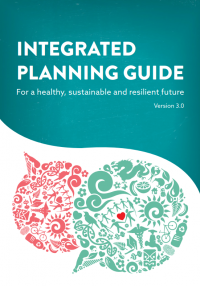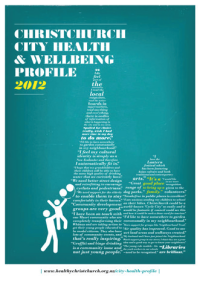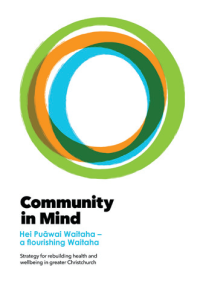Te Kōwatawata
Te Kōwatawata is a document which both celebrates the role of Ngāi Tahu and Ngā Mātā Waka in the recovery and sets out a vision for ongoing recovery. The vision is:
Ngāi Tahu and Ngā Mātā Waka lead their recovery on their own terms, from whānau up, supported by Ngāi Tahu and Ngā Mātā Waka, government, private and community sectors to create transformational change that will:
- Embed and celebrate identities in the recreated greater Christchurch.
- Champion and accelerate the talent of whānau and communities to realise their aspirations.
- Restore and replenish the environment.
- Strengthen partnerships that enhancing civic leadership.
Healthy Christchurch
Healthy Christchurch(external link) is an initiative consisting of over 200 organisations, led by the CDHB.
Members of the network have signed the healthy Christchurch Charter, and are working towards improving physical activity and nutrition and reducing health inequalities of Christchurch residents.
Integrated Planning Guide (version 3)

The Greater Christchurch Partnership is delighted to endorse this updated Integrated Planning Guide (IPG) [PDF, 3.3 MB], which ultimately aims to achieve more sustainable places, better health outcomes and greater wellbeing for all members of our communities.
Responding to a need to broaden the focus beyond recovery, the IPG provides a versatile tool to help integrate outcomes thinking relevant to health, wellbeing and sustainability into policy and plan making.
The IPG can be used multiple ways during planning and policy development to assess impacts. The targeted questions aim to enhance constructive thinking and encourage innovation. This tool can be used as a desk guide right through to being the focus at stakeholder meetings or integrated assessments.
Healthy Christchurch City Health Profile (2012)
The Christchurch City Health and Wellbeing Profile (2012)(external link) was developed through the Healthy Christchurch network with public consultation occurring in 2009 and 2010.
The profile identifies key issues that are important to Christchurch residents in creating healthy people and communities.
All Right? Campaign
The All Right? Campaign(external link) is an initiative led by the CDHB and the Mental Health Foundation of New Zealand.
The campaign was launched in 2013 to encourage people to think about their mental health and wellbeing during the recovery from the Canterbury earthquakes.
Community in Mind Strategy, Shared Programme of Action and Canterbury Wellbeing Survey
The Community in Mind (external link)Strategy was released by the now disestablished CERA in 2014. It was developed by a diverse group of agencies and organisations.
The Strategy contains objectives for each of the six key areas identified within the Recovery Strategy - leadership and integration, economic recovery, social recovery, built environment and natural environment. The Strategy also contains a number of priority actions.
 The Community in Mind Shared Programme of Action was first released in 2015 and has recently been reviewed and updated. The Shared Programme of Action aims to improve the community and individual resilience, as well as supporting people to lead their recovery.
The Community in Mind Shared Programme of Action was first released in 2015 and has recently been reviewed and updated. The Shared Programme of Action aims to improve the community and individual resilience, as well as supporting people to lead their recovery.
Canterbury DHB and the Ministry of Health inherited the psychosocial recovery monitoring from CERA in March 2016.
The Canterbury Wellbeing Survey(external link) collects data on the self-reported wellbeing of Greater Christchurch residents, as well as their perceptions of the recovery. The survey is undertaken every six months.
CDHB Public Health Plan (2015-16)
The Canterbury District Health Board’s Public Health Plan(external link) describes public health services provided or funded by the Canterbury District Health Board and it's Public Health Unit (Community and Public Health) and highlights key relationships with other agencies.
Canterbury Health in All Policies Partnership (CHIAPP)
 The Canterbury Health in all Policies Partnership is made up of Christchurch City Council. Canterbury District Health Board, Environment Canterbury and Te Rununga o Ngāi Tahu.
The Canterbury Health in all Policies Partnership is made up of Christchurch City Council. Canterbury District Health Board, Environment Canterbury and Te Rununga o Ngāi Tahu.
CHIAPP(external link) has undertaken a number of Health Impact Assessments and Integrated Assessments, including for the Urban Development Strategy (2007), Land Use Recovery Plan (LURP)(external link), the Lyttleton Port Recovery Plan, Christchurch Transport Plan(external link), and draft Central City Plan(external link).
Integrated Recovery Planning Guide
The Integrated Planning Guide(external link) was developed to assist groups involved in recovery.
The guide is designed to help planning in the recovery achieve more sustainable social, environmental and economic outcomes; to promote health; and to keep sight of the shared vision for stronger, healthier and more resilient communities.
Proposed Canterbury Air Plan
The Proposed Canterbury Air Plan(external link) sets out how we are going to manage air pollution from home heating, industry and other sources like outdoor burning, dust and odour.
Right now the decision version of the proposed air plan is being treated as operative.
EECA Energywise Warm Up New Zealand: Healthy Homes Programme
Warm Up New Zealand: Healthy Homes Programme(external link) provides free ceiling and underfloor insulation to low-income households.
Greater Christchurch Sports and Recreation Recovery Programme
'Spaces, Places and People: Recovery Programme for Sport and Recreation in Greater Christchurch'(external link) was developed by the Sport and Recreation Earthquake Leadership Group. The Recovery Programme seeks to re-establish Greater Christchurch as the home of highly accessible places and spaces which promote participation and attract major sport and recreation events.
Safer Christchurch
Safer Christchurch(external link) sets the strategic direction for the Safer Christchurch Interagency Group.
The strategy provides a unified approach to safety, with an emphasis on injury prevention, road safety and crime prevention - Christchurch working towards being designated a World Health Organisation Safe Community and becoming the safest city in New Zealand.
Collaboration and coordination among government agencies and community organisations are key to this Strategy.
Greater Christchurch Capacity Assessment
Produced in 2018, the Greater Christchurch Partnership has prepared a Housing and Business Development Capacity Assessment [PDF, 1.9 MB] (‘capacity assessment’) as part of a review of the settlement pattern for Greater Christchurch.
The capacity assessment provides information about current housing and business trends to inform future planning responses across Greater Christchurch. Such an assessment is also a requirement of the National Policy Statement on
Urban Development Capacity (NPS-UDC) 2016.
Further information on the Settlement Pattern Review.
Greater Christchurch Housing Market Assessment
Produced in 2013, the Housing Market Assessment [PDF, 3.5 MB] looks at housing trends in greater Christchurch.
The report examines likely trends up to 2031. The report contains a detailed analysis, long term trend data and examines post-earthquake changes. Areas covered include housing demand, housing supply, the supply/demand balance and housing affordability.
The report covers both the rental and homeownership markets.
Build Back Smarter
Build Smarter(external link) is a joint initiative involving EECA Energywise, MBIE and CCC. It is a free service providing homeowners with face to face advice on how to make homes warmer, drier, healthier and cheaper to run. The service is available to all homes in the Greater Christchurch area.
Housing Accords with Government
The Housing Accord and Special Housing Areas Act was introduced in 2013. The purpose of the Act is to address issues of housing supply and affordability in specific areas throughout New Zealand.
Christchurch City, Waimakariri and Selwyn Districts are listed in the Act as districts identified as having housing supply and affordability issues.
Christchurch City Council ratified the Christchurch Housing Accord(external link) in September 2014, and Selwyn District Council ratified the Selwyn District Housing Accord in December 2015.
The amended Accord(external link) was ratified by the Council in May 2017.
Central City Living research
A survey was undertaken by Opus Research during 2013 and looked at the preferences of potential central city residents.
The survey looked at their lifestyle priorities, stages of the rebuild when they may choose to move into the central city and some of the cost trade-offs they would be expected to make.
Key findings from the survey include that it is likely that a diverse market exists for central city living, local residents can provide a market for central city businesses and that a range of dwelling types and amenities are required.
Ōtautahi Community Housing Trust
In 2016 Christchurch City Council established a charitable trust to manage the social housing service provided by the council.
The Ōtautahi Community Housing Trust(external link) is the largest social housing provider in the South Island. Any surplus money will be reinvested into social housing to improve the services to tenants and the wider Christchurch community.
